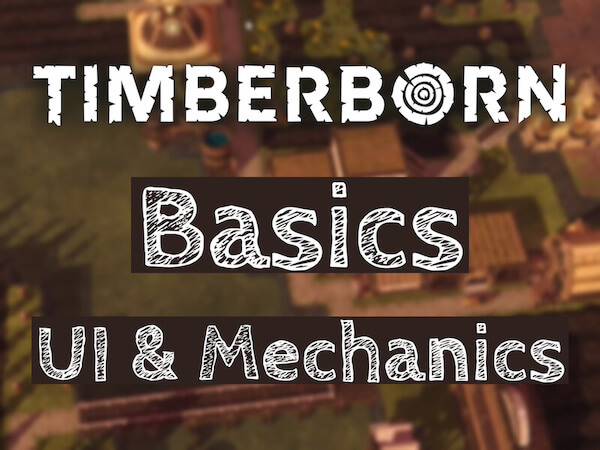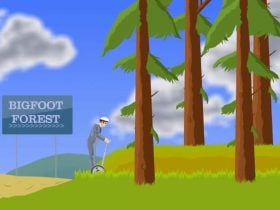Welcome to our comprehensive guide on Timberborn, an intricate city-building game teeming with industrious beavers and unique challenges. Despite its complex mechanics, Timberborn’s intuitive interface makes it an accessible experience for all types of players, as we’ve highlighted in our detailed Timberborn review.
In this overview of the basics, we’ll delve into the game’s various tabs and their functionalities, explaining how each contributes to your beaver city’s prosperity. Whether you’re a seasoned city-builder or a newcomer to the genre, this guide will help you master the diverse tools and resources at your disposal in Timberborn. Let’s dive in and start building!
Timberborn Basics: All 17 Mechanics
Cut Trees
The Cut Trees tab in Timberborn is a critical gameplay tool used to mark specific trees for cutting by your beaver colony. It works in tandem with the Lumberjack Flag, found under the Wood tab.
To use them effectively, place the Lumberjack Flag near a cluster of trees to define a harvestable area. Then, using the Cut Trees tab, highlight the trees in this area you want to be chopped down.
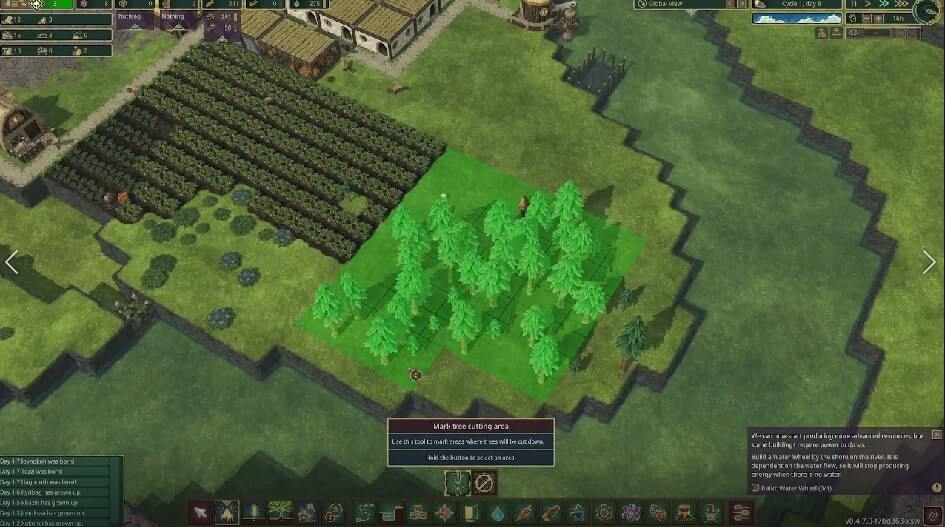
Your beaver lumberjacks will then begin cutting down the designated trees, providing a vital source of wood for your colony. Careful and sustainable use of these tools is key to preventing deforestation and maintaining a steady wood supply.
Plant Trees and Bushes
The Plant Trees and Bushes tab in Timberborn plays a significant role in long-term resource management and sustainability in the game. It provides the option to designate plots of land where different types of trees and bushes can be grown and later harvested. This is particularly important as the game progresses, as maintaining a steady supply of wood and other resources becomes increasingly critical for the survival and growth of your beaver civilization.
To use this tab effectively, you’ll need to employ a Forester, which can be found under the Wood tab. The Forester is a key character in the game, responsible for planting trees and bushes in the areas you’ve designated. They ensure that your colony does not exhaust its resources over time.
After placing a Forester’s Hut in the vicinity of the area you want to reforest, you can then use the Plant Trees and Bushes tab to mark the specific plots of land where you’d like trees and bushes to be grown. The Forester will then get to work planting saplings, which will grow into fully-fledged trees or bushes over time.
It’s important to note that the growth of trees and bushes is not instantaneous, requiring some forethought and strategic planning. Without the proper use of the Plant Trees and Bushes tab and a functioning Forester, your civilization can quickly deplete its natural resources, leading to potential crises in the later stages of the game. By continuously planting new trees and bushes, you ensure that your beavers have a renewable source of wood and other resources, promoting the sustainable growth of your civilization.
Demolish
The Demolish tab in Timberborn serves a strategic purpose in the management and modification of your beaver civilization’s landscape and structures. As the name suggests, this tool allows you to mark buildings and natural items like bushes for demolition.
To use this feature, simply access the Demolish tab, then select the structures or landscape features you want to remove from your beaver settlement. These items will be marked for demolition, and worker beavers will promptly start the process of tearing them down.
One of the unique aspects of the Demolish tab is that it allows for resource recovery. When you demolish a building, worker beavers can retrieve some of the resources, called Rubble, that were initially used in its construction. These materials are not lost but returned to your resource pool, ready to be utilized in other building projects.
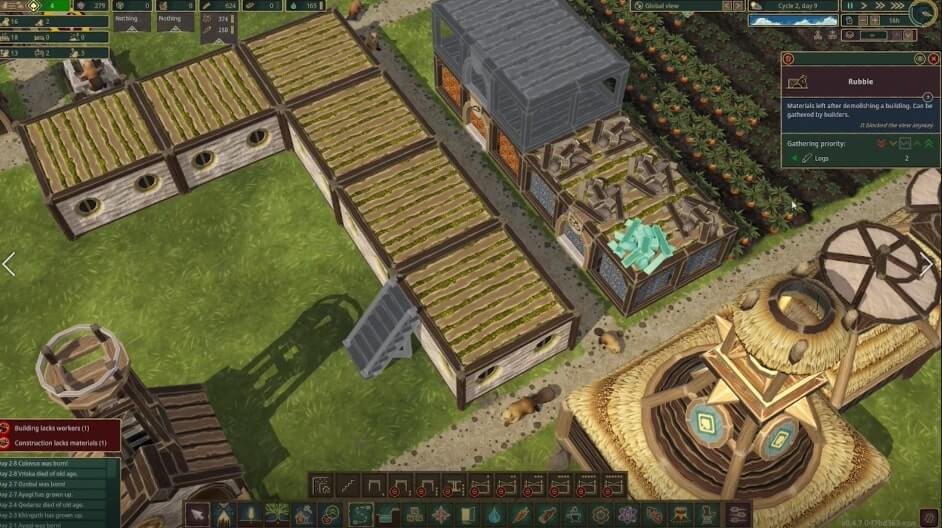
This recycling of resources can be crucial in the game, especially in situations where materials are scarce or when you need to quickly redirect resources to other, more urgent projects. The Demolish tab, therefore, not only gives you the flexibility to redesign your settlement as needed but also helps optimize resource management in your beaver civilization.
Paths
The Paths tab in Timberborn is a key tool for facilitating movement and transport within your beaver settlement. It allows you to construct walkways around your city at no cost, providing essential connectivity for your buildings and helping to streamline the movement of goods and beavers around your city.
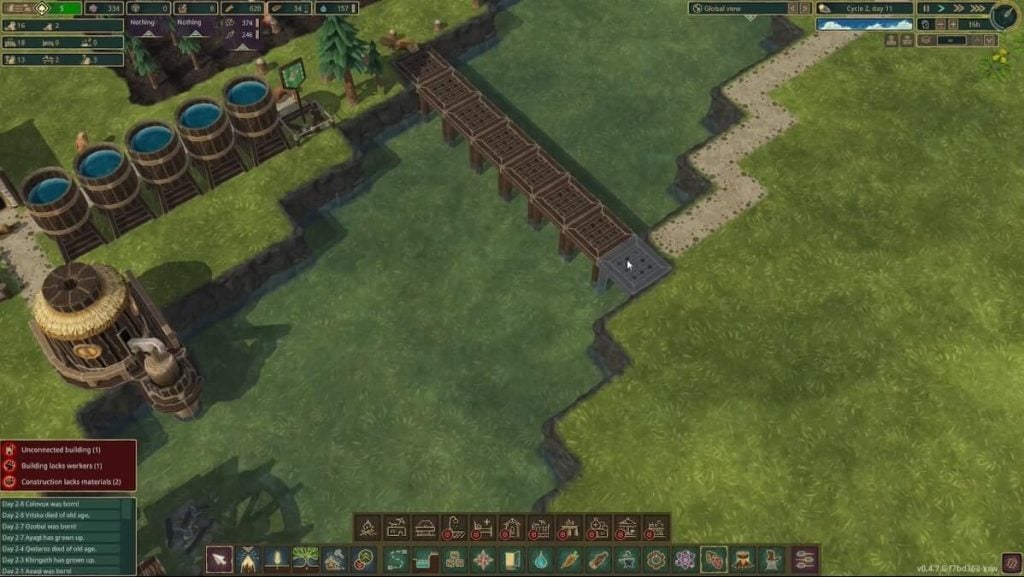
The Paths tab also extends beyond just flat walkways. It allows you to add a vertical dimension to your city, supporting the game’s emphasis on vertical construction. This is where you’ll find the tools to build stairs, platforms of various sizes, and suspension bridges. These structures enable you to make full use of the three-dimensional space in your city, building up as well as out.
Stairs and platforms are essential for navigating changes in terrain elevation and constructing multi-level buildings. They help your beavers reach higher ground and can be a key part of strategic city planning.
Suspension bridges, on the other hand, allow you to span gaps and water bodies in your city, connecting areas that might otherwise be inaccessible. They can be a crucial tool for expanding your city and exploiting resources that are on the other side of rivers or cliffs.
Remember, most buildings require a connection to a path to function properly, so it’s crucial to plan your paths wisely. The Paths tab is not just about creating walkways, it’s about designing an efficient transport network that keeps your city running smoothly. Proper use of the Paths tab can lead to a more efficient, productive, and prosperous beaver civilization.
Landscaping
The Landscaping tab in Timberborn is a pivotal tool for controlling and shaping your environment to suit the needs of your beaver settlement. It offers an array of options for both water management and terrain manipulation. It’s an essential basic.
In terms of water management, the Landscaping tab houses key structures such as dams, levees, and floodgates. These structures are critical in regulating the flow of water in and around your city. Dams can be used to create reservoirs or redirect water flow, levees help prevent unwanted flooding, and floodgates can be opened or closed to control water levels. Mastering water management becomes increasingly important as your settlement expands and the demand for water resources grows.
Beyond water management, the Landscaping tab also provides tools to shape the very terrain of your game environment. Here, you’ll find an Explosives Factory, dynamite, and a Terraforming Station, all of which can be used to dramatically alter the landscape.
The Explosives Factory produces dynamite, which can be used to blast away terrain, create space for construction, or create new water paths. The Terraforming Station, on the other hand, allows for more precise control over the landscape, enabling you to raise or lower terrain as needed.
Storage
The Storage tab in Timberborn is crucial for managing your beaver civilization’s resources effectively. It allows you to construct different-sized storage buildings where you can stockpile excess production of wood, food, and water.
These storage facilities are essential for maintaining a buffer of resources that your beaver society can rely on during lean times, such as during a drought. Without sufficient storage, any surplus resources produced by your beavers would go to waste, and in times of scarcity, your civilization could face shortages and potential crises.
The Storage tab provides options for various sizes of storage buildings, catering to different storage needs. Smaller buildings can be built quickly and easily to handle immediate storage needs, while larger buildings can provide a significant reserve of resources, though they may require more time and resources to construct.
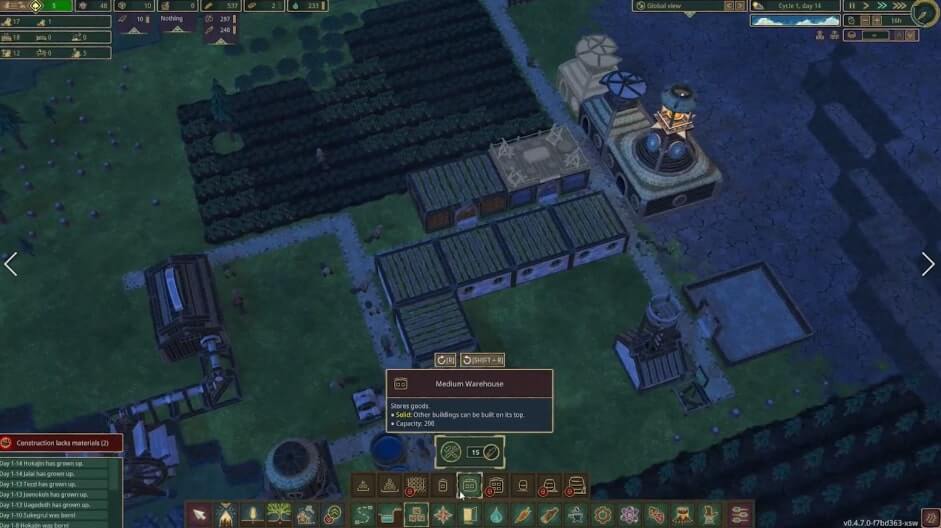
Storage buildings must be strategically placed within your city for efficient resource distribution. They should ideally be located near production sites to minimize the distance that workers have to travel to store goods, but also accessible to the areas where resources are most needed.
District Management
The District Management tab in Timberborn is instrumental in expanding your beaver civilization and managing its complexity as it grows. This tab allows you to establish new districts, each functioning as a semi-independent unit with its own population and resources.
New districts are essentially new settlements that can be set up in different parts of the game map. Each district has its own population of beavers, and these beavers can independently gather and use resources within their district. This allows for a degree of specialization, where certain districts might focus on specific types of resource production based on their local environment.
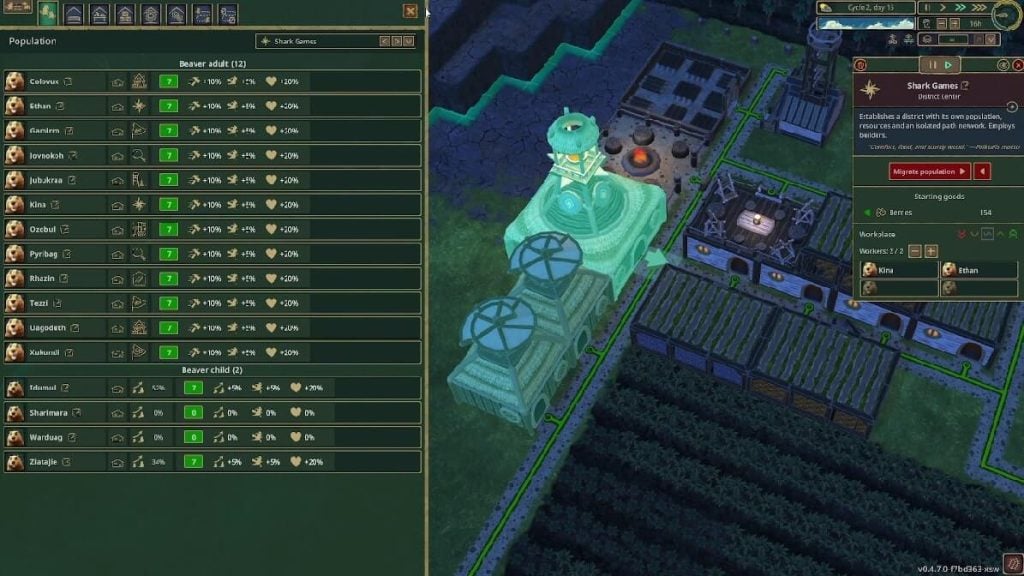
The District Management tab also provides options for building auxiliary structures like Hauling Posts and Builder’s Huts. Hauling Posts enable you to assign beavers to transportation roles, ensuring efficient movement of goods within and between districts. Builder’s Huts, on the other hand, allow you to increase the number of beavers that can work on construction projects, accelerating your building processes.
Crucially, this tab also features District Crossings. These structures are vital for inter-district cooperation, allowing districts to share resources with one another. This is particularly important when a new district lacks certain resources necessary for its operation. Through a District Crossing, resources can be transported from a district where they are abundant to a district where they are scarce, ensuring the smooth running of your entire civilization.
Housing
The Housing tab in Timberborn is where you’ll manage the residential needs of your beaver civilization. This tab offers a selection of housing options of varying sizes that can accommodate your growing beaver population.
Housing is a straightforward but crucial aspect of the game. Each housing unit you build provides shelter for a certain number of beavers. Smaller housing options can be built quickly and efficiently, ideal for a young settlement just starting out. As your population expands, you might opt for larger housing units that can accommodate more beavers.
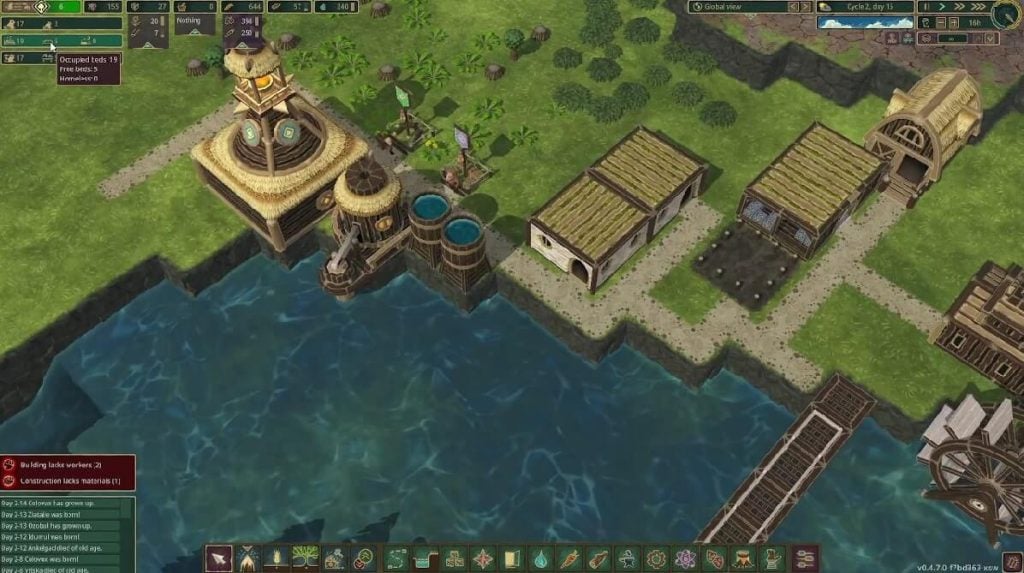
A key factor to remember is that housing is directly linked to population growth in your beaver civilization. Beavers need a home to reproduce and increase their population. Without sufficient housing, your population growth will stagnate, limiting your workforce and, in turn, the growth and prosperity of your civilization.
Water
The Water tab in Timberborn is a crucial component in maintaining the survival and prosperity of your beaver civilization. It provides a selection of tools and structures for managing your settlement’s water needs, each playing a unique role in the overall water management system.
A key item found in this tab is the Water Pump. Water Pumps allow your beavers to extract and store water from bodies of water, like rivers. The stored water serves two purposes: it provides a daily supply of drinking water for your beavers and acts as a reserve during periods of drought. Maintaining a good number of functioning water pumps is vital to ensure a steady water supply.
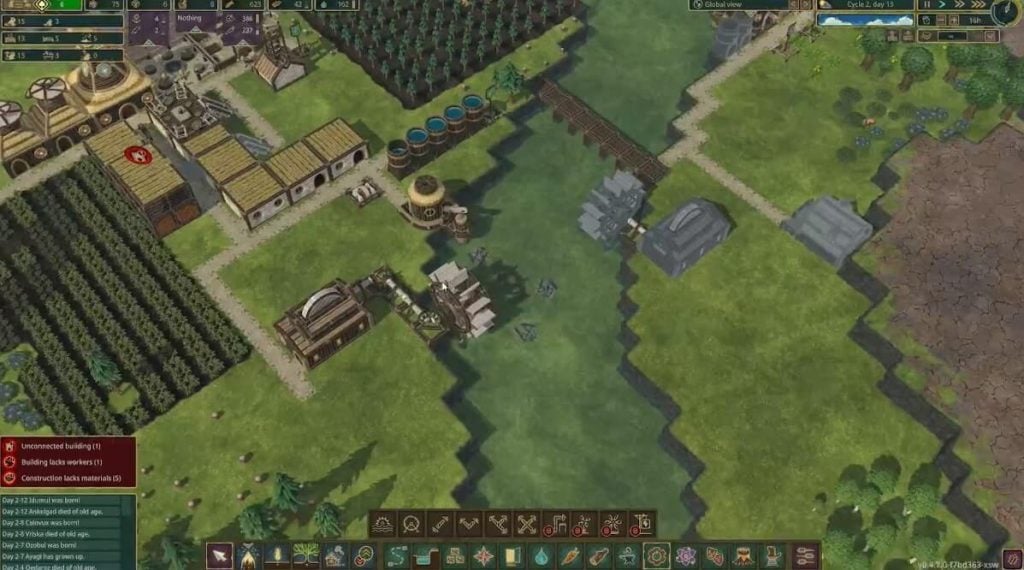
The Water Dump is another useful tool found under this tab. It allows you to move water from one location to another. This can be particularly useful when you need to redirect water for irrigation, or when you’re trying to manage the water levels in your settlement to prevent flooding or to preserve water during a drought.
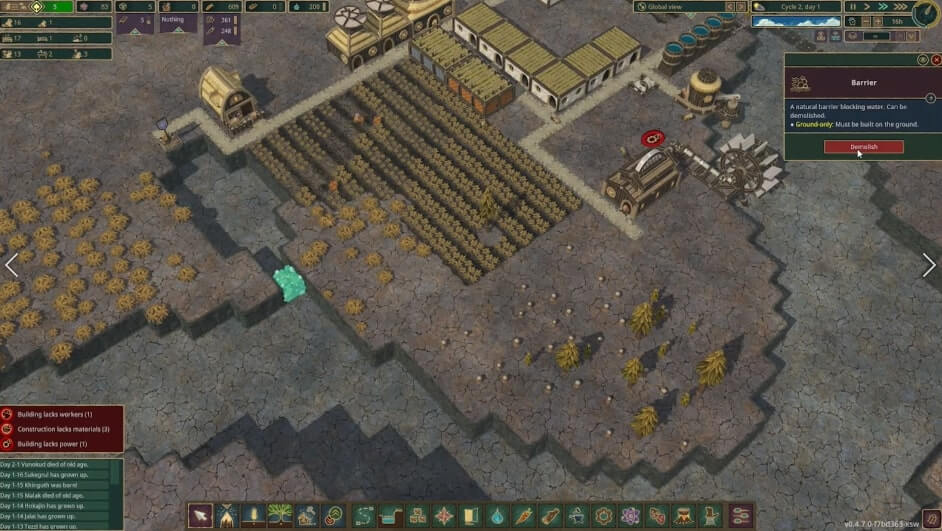
The Irrigation Tower is a unique structure that helps improve the fertility of the surrounding land. By irrigating and fertilizing barren land, it enables the growth of trees and bushes, thus expanding the productive capacity of your land.
Food
The Food tab in Timberborn is the hub for managing your beaver civilization’s sustenance needs. It offers a range of buildings and tools to gather, grow, and prepare food, each contributing to the well-being and survival of your beaver society.
Early in the game, the Gather Flag is a vital tool you’ll find under this tab. By placing a Gather Flag near bushes, your beavers can forage for food, providing an early and easy source of nourishment. This is a crucial first step in setting up your food supply.
As you progress, the Farmhouse becomes available, enabling the cultivation of various crops. With a farmhouse, you can plant and harvest a range of crops, providing a reliable and renewable source of food for your city. This marks a significant step in your civilization’s development, moving from foraging to agriculture.
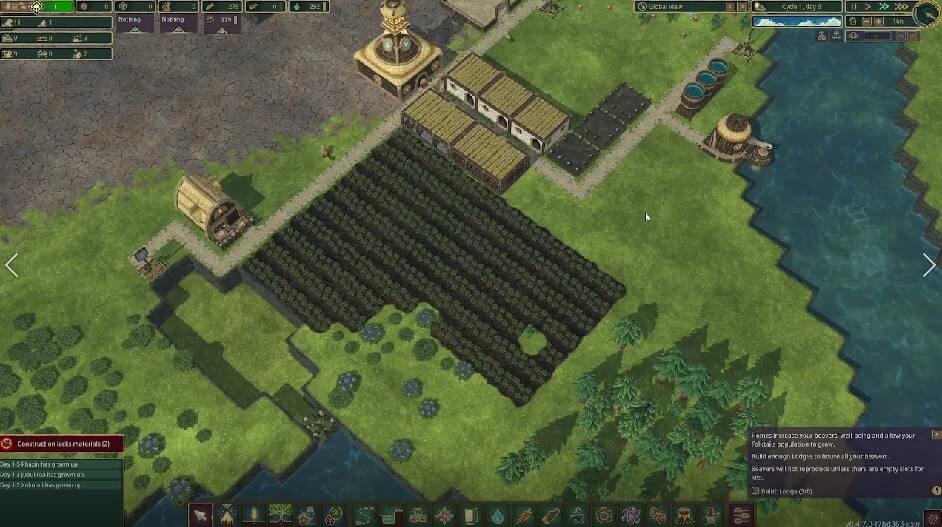
The Food tab also offers a selection of advanced food buildings such as Grills, Gristmills, Bakeries, and Beehives. These structures enable the production of a greater variety of food items, each with different benefits.
Grills, for example, allow you to cook food, providing more nourishment from the same amount of raw food. Gristmills and Bakeries enable you to process crops into flour and then bake it into bread, offering a valuable food source, especially in the colder seasons. Beehives, on the other hand, allow the production of honey, a treat that can boost the well-being of your beavers.
Wood
The Wood tab in Timberborn is fundamental to your resource production and infrastructure development. It contains a range of tools and buildings dedicated to the harvesting, processing, and usage of wood, which forms the backbone of your beaver civilization’s growth.
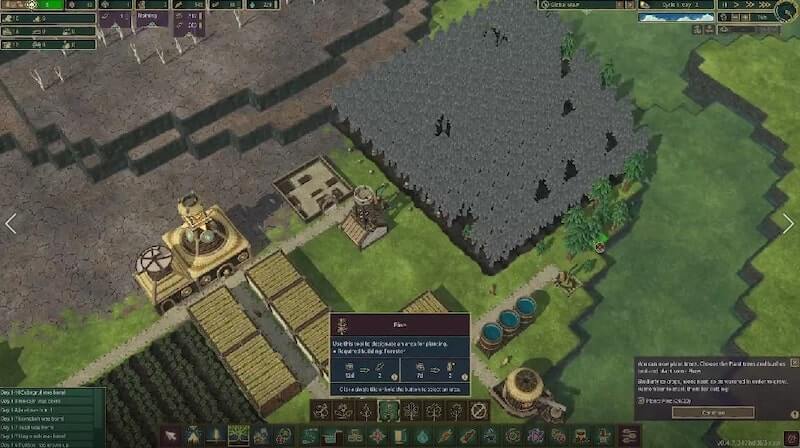
One of the first tools you’ll use from this tab is the Lumberjack Flag. By placing a Lumberjack Flag near a cluster of trees, you designate beavers to chop down trees and collect timber. This harvested timber serves as the primary building material in the early stages of your city’s development.
Soon after, the Lumbermill becomes available, enabling the processing of raw timber into refined lumber. This processed lumber is a more advanced resource that is required for constructing more complex buildings and structures. The Lumbermill thus marks a significant step in your civilization’s technological progression.
The Forester’s Station, another crucial feature under this tab, allows for the replanting of trees. By placing a Forester’s Station, you ensure a continuous supply of timber by having beavers plant new trees once they’ve chopped down existing ones. This is particularly important to prevent the exhaustion of your initial tree supply, securing a sustainable lumber production chain for your society.
As you advance in the game, the Wood tab expands to include more advanced factories like the Gear Workshop, Papermill, Printing Press, and Trapper Station. These are unlocked with science points and provide an array of products, from gears necessary for certain machines, to paper for the Printing Press, and even traps for the Trapper Station to catch game.
Metal
The Metal tab in Timberborn is central to your civilization’s ability to harness and utilize metal, a valuable resource that enables advanced building and manufacturing.
Early in your city’s development, you’ll have access to the Scavenger Flag from this tab. By placing a Scavenger Flag near the ruins of the old world, your beavers can gather metal, an essential resource for constructing more complex buildings and machinery.
As you progress in the game, the Smelter becomes available. This building allows you to process the scavenged metal, refining it into a more useful form. The processed metal can then be used in a variety of advanced buildings and technologies, driving your civilization’s technological advancement.
In later stages, the Metal tab provides access to a Mine. The Mine allows your beavers to delve into underground ruins and extract additional resources. This can be a critical source of metal and other resources when surface supplies become scarce or are exhausted.
Power
The Power tab in Timberborn is integral to managing your civilization’s energy needs. It provides a range of tools and structures for generating and distributing power, playing a pivotal role in the operation of many advanced buildings and technologies.
Initially, you’ll start generating power using simple structures like Water Wheels and Power Wheels. Water Wheels generate power by harnessing the flow of water, making them ideal for locations near rivers or streams. Power Wheels, on the other hand, are powered by beavers running on them, providing a reliable if labor-intensive source of energy.
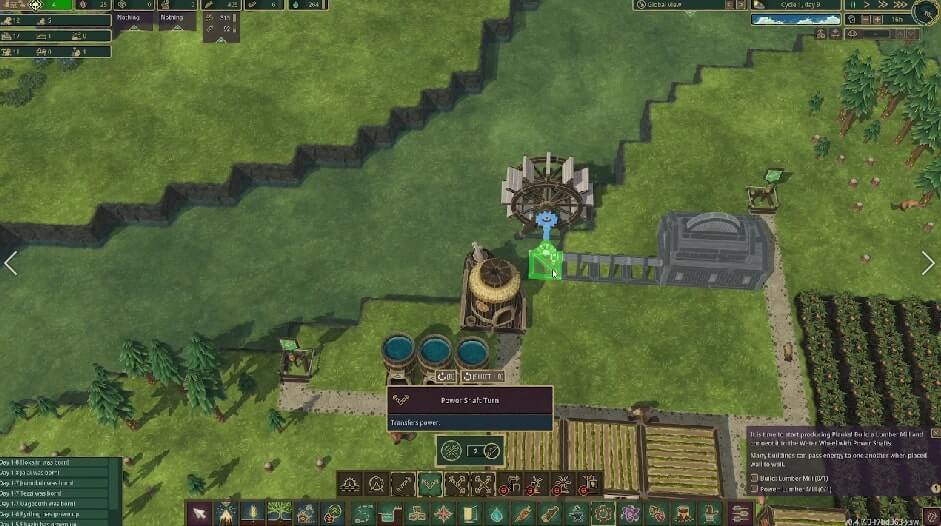
As your civilization advances, you’ll gain access to Windmills of different sizes. These structures harness the power of the wind to generate energy, offering a renewable and non-labor-intensive source of power.
Notably, the Power tab also includes Power Shafts, which transport power from your generators to the buildings that require it. These shafts can be arranged in various configurations to best suit your settlement’s layout and the positioning of your power-dependent structures.
While power management may seem relatively straightforward in the early stages of the game, it becomes increasingly complex and important as you progress. Many advanced buildings require power to operate, and efficient power generation and distribution become crucial to maintaining the smooth operation of your society.
Science
The Science tab in Timberborn plays a central role in advancing your civilization’s technological prowess. It contains a variety of buildings that generate science points and develop advanced technology, thereby facilitating the evolution of your beaver society.
One of the first buildings you’ll likely construct from this tab is the Inventor’s Hut. By employing beavers in the Inventor’s Hut, you generate science points passively over time. Similarly, the Observatory, a more advanced structure, also contributes to the generation of science points. These points are essential for unlocking new and more sophisticated buildings and technologies that can greatly enhance your city’s productivity and sustainability.
As you move into the late stages of the game, more advanced options become available. The Refinery is one such building, which transforms food and water into fuel. This fuel can be used to power advanced machinery and technologies, adding a new layer of complexity to your resource management.
Eventually, you’ll unlock the Bot Factory and Bot Assembler. These remarkable structures allow you to create robots that can assist your beavers in their daily tasks. The introduction of robots significantly increases your workforce’s efficiency and capacity, allowing your society to handle more complex tasks and larger infrastructure projects.
Well-Being
The Well-being tab in Timberborn is key to fostering a happy and healthy beaver society. It offers a variety of buildings and amenities that contribute to the well-being of your beaver population, enhancing their satisfaction and productivity.
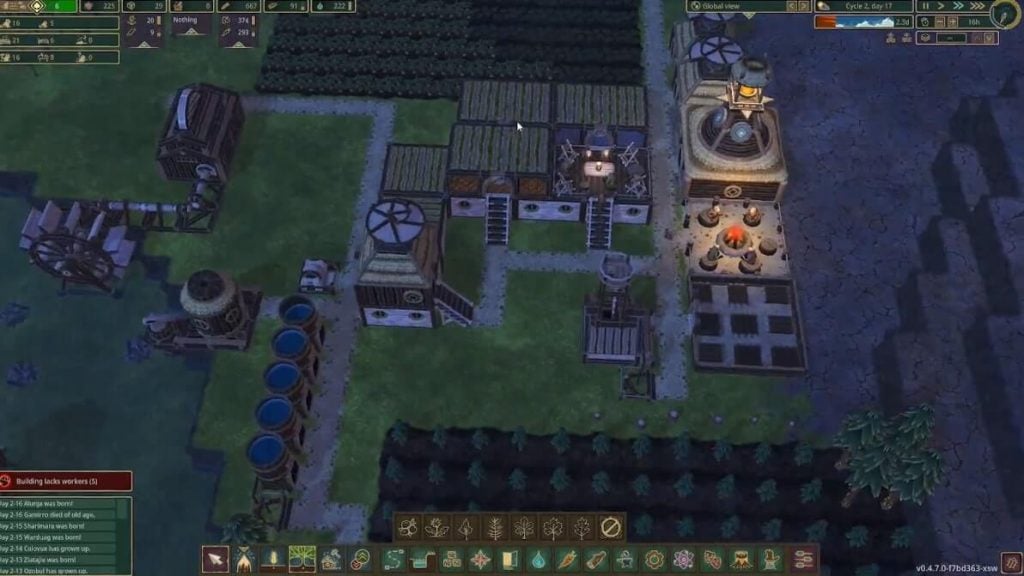
Early in the game, you’ll have access to simple structures like the Campfire, Rooftop Terrace, and Teeth Grinder. The Campfire offers a social space for your beavers, promoting community bonds and overall happiness. The Rooftop Terrace provides a place for relaxation and leisure, while the Teeth Grinder helps to maintain your beavers’ dental health – an important consideration given their reliance on their teeth for various tasks.
As your society advances, you’ll unlock a wider array of well-being structures using science points. Showers and Medical Beds improve health and hygiene, while Lidos offer recreational water areas. Temples provide spiritual enrichment, and Healers can tend to sick or injured beavers.
Mud Baths provide a unique form of relaxation and skin care for your beavers, and Carousels offer entertainment and fun. Many of these structures not only boost well-being but also serve practical purposes. For example, the Teeth Grinder not only makes beavers happy but also repairs broken beaver teeth, ensuring they can effectively carry out their tasks.
Decorations
The Decorations tab in Timberborn is your gateway to enhancing the aesthetic appeal and liveliness of your beaver city. This tab offers a variety of items that can not only beautify your city but also contribute to the well-being of its beaver inhabitants.
From simple Benches to ornate Beaver Statues, each item under this tab serves to enrich your city’s visual appeal. Benches can be placed around your city to provide resting spots for your beavers, enhancing their comfort and satisfaction. They are more than mere decorations; they contribute to the well-being of your beavers by providing a place for them to rest and recuperate.
Rooftops can be added to your lodges, enhancing their aesthetic appeal and providing additional leisure spaces for your beavers. These outdoor spaces can boost the well-being of your beavers, offering places for social interaction and relaxation.
Scarecrows and Beaver Statues offer a playful touch to your city’s landscape. Not only do they liven up your city, but they can also contribute to your beavers’ happiness, enhancing their environment with art and whimsy.
Finally, Fences can be built to delineate spaces within your city or to add a decorative edge to paths and buildings. They can help organize your city and enhance its visual appeal.
Monuments
The Monuments tab in Timberborn offers a selection of grand structures that serve not only as iconic landmarks but also as potent boosters of well-being within your beaver city. Each monument has a unique effect that benefits your beavers within a specified radius, making them strategic assets to your society.
The Farmers’ Monument, for instance, is an ode to the hard work and dedication of your beaver farmers. Erecting this monument not only embellishes your cityscape but also bolsters the well-being of beavers within its influence area. The presence of this monument can inspire your farmers, increasing their satisfaction and productivity.
The Brazier of Bonding is another remarkable structure that promotes social cohesion among your beavers. This monument symbolizes unity and camaraderie, fostering stronger bonds within your beaver society. It enhances the well-being of all beavers within its radius, making it a valuable addition to any bustling district of your city.
The Fountain of Joy, meanwhile, is a symbol of exuberance and vitality. This monument radiates positivity, uplifting the spirits of your beaver citizens and enhancing their well-being. Its presence can significantly boost morale, contributing to a happier and more vibrant society.
While these monuments require substantial investment in terms of science points, the benefits they offer make them worthwhile. They not only enhance the aesthetic appeal of your city but also significantly improve the quality of life for your beavers.
Summary
That concludes our in-depth exploration of Timberborn’s basics, covering the various tabs and their functionalities. As we’ve seen, Timberborn is a detailed and captivating city builder, with numerous components that contribute to the success and sustainability of your beaver society. With the aid of this guide and the game’s intuitive user interface, you’re now equipped with the knowledge to navigate these complexities and architect a truly thriving city. So, gear up, plan strategically, and let your creative instincts guide you in building a beaver metropolis for the annals of history. Happy building!
For more on Timberborn, check out our in-depth review.
